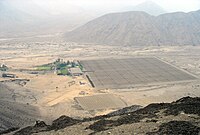
Photo from wikipedia
Plasma irregularities in the equatorial E–region ionosphere are classified as Type–I or Type–II, based on coherent radar spectra. Type–I irregularities are attributed to the Farley–Buneman instability and Type–II to the… Click to show full abstract
Plasma irregularities in the equatorial E–region ionosphere are classified as Type–I or Type–II, based on coherent radar spectra. Type–I irregularities are attributed to the Farley–Buneman instability and Type–II to the gradient–drift instability that cascades to meter–scale irregularities detected by radars. This work presents the first kinetic simulations of coupled Farley–Buneman and gradient–drift turbulence in the equatorial E–region ionosphere for a range of zeroth–order vertical electric fields, using a new approach to solving the electrostatic potential equation. The simulation models a collisional quasineutral plasma with a warm, inertialess electron fluid, and a distribution of NO+ ions. A 512–m wave with a maximum/minimum of ±0.25 of the background density perturbs the plasma. The density wave creates an electrostatic field that adds to the zeroth–order vertical and ambipolar fields, and drives Farley–Buneman turbulence even when these fields is below the instability threshold. Wave power spectra show that Type–II irregularities develop in all simulation runs and that Type–I irregularities with wavelengths of a few meters develop in the trough of the background wave in addition to Type–II irregularities as the zeroth–order electric field magnitude increases. Linear fluid theory predicts the growth of Type–II irregularities reasonably well but it does not fully capture the simultaneous growth of Type–I irregularities in the region of peak total electric field. The growth of localized Type–I irregularities represents a parametric instability in which the electric field of the large–scale background wave drives pure Farley–Buneman turbulence. These results help explain observations of meter–scale irregularities advected by kilometer–scale waves.
Journal Title: Journal of Geophysical Research
Year Published: 2017
Link to full text (if available)
Share on Social Media: Sign Up to like & get
recommendations!